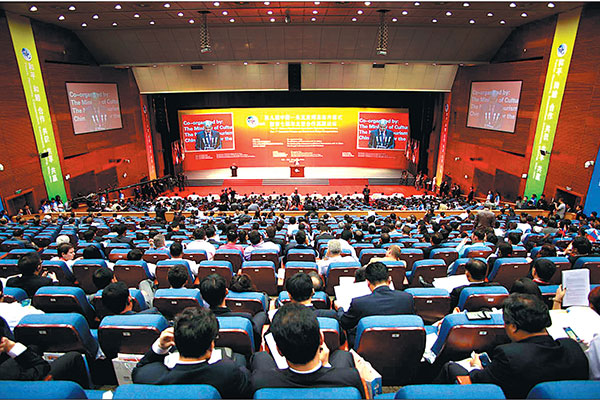
Chinese and foreign guests attend the opening ceremony of a China-Northeast Asia Expo held in previous years in Changchun, Jilin province.[Photo/Xinhua]
The 11th China-Northeast Asia Expo, a cross-border platform for business cooperation among Northeast Asian countries, will significantly increase the interconnectivity of the countries.
That’s according to a leading official from China’s top economic planner, who added that it will further contribute to the integration of Northeast China with the development of the Belt and Road Initiative.
Zhou Jianping, director of the National Development and Reform Commission’s department for the revitalization of the Northeast region, was talking ahead of this year’s event at a recent news conference in Beijing.
The expo will be held from Sept 1 to 5 in Changchun, capital of Jilin province.
“The expo showcases China’s neighborhood diplomacy, featuring mutual understanding, sincerity, mutual benefit and inclusiveness, and promotes the win-win cooperation between China and countries in the region,” Zhou said.
Underscoring the expo’s importance were the other attendees to the news conference.
These included Wu Zhengping, head of the Ministry of Commerce’s department of Asian affairs; Yin Zonghua, vice chairman of the China Council for the Promotion of International Trade; and Li Jinxiu, vice-governor of Jilin province.
The expo, which was established under the aegis of the Chinese government in 2005, has catered to the demands of regional economic development and strengthened the personnel exchanges between the countries, Wu said.
In 2016, the trade volumes between China and the five countries in Northeast Asia-Russia, Japan, the Republic of Korea, Mongolia and the Democratic People’s Republic of Korea-totaled $605.9 billion, accounting for 16.4 percent of China’s foreign trade, Wu said, citing ministry statistics.
Japan and the ROK are China’s second and third-biggest trading partners, and the two countries are also the second and third-largest sources of foreign investment in China, with ROK’s investments in China totaling $4.75 billion last year, with that of Japan totaling $3.1 billion.
Meanwhile, China is also increasing investment in those countries, Wu said.
Moreover, China is speeding up construction of long-term economic cooperation mechanisms with them, he added.
The China-Japan-ROK Free Trade Agreement negotiations were going on steadily, and the construction of the China-Mongolia-Russia Economic Corridor had made great strides, he said.
“Against the backdrop of a global economic downturn, countries in Northeast Asia should make full play of the advantages of geographical proximity and economic complementarity and pursue innovative development by focusing on such strategies as the Belt and Road Initiative,” Wu said.
Zhou said the central government had in recent years paid great attention to the revitalization of Northeast China, once the country’s industrial base, as the region was hit by an economic downturn.
The State Council has issued a range of measures in the past year to promote economic restructuring in the region, Zhou said.
The economies of the three provinces in the region-Heilongjiang, Jilin and Liaoning - were stabilizing and showing positive signs.
He added that the National Development and Reform Commission would help the region integrate into the Belt and Road Initiative and build it into a regional economic hub for Northeast Asia.
The China Council for the Promotion of International Trade’s Yin Zonghua said the theme of this year’s expo was innovation, openness, inclusiveness and cooperation.
Yin said it coincides with the economic development strategies of Northeast Asian countries and reflects regional enterprises’ demand for “win-win cooperation”.
As the co-host of this year’s expo, the council will stage an exhibition featuring intelligent manufacturing, a roundtable meeting focusing on the Belt and Road Initiative’s role in regional economic cooperation, and a seminar on business law services, Yin said.
Li Jinxiu, vice-governor of Jilin, said that his province, as the host of the expo, sees great opportunities for development amid the country’s strategy of revitalizing Northeast China.
The province was shouldering “great responsibility” to hold a professional and efficient exhibition.
Innovation will be a highlight of the expo, which has 2,800 booths with a total exhibition area of 63,000 square meters.
“For the first time, a pavilion featuring intelligent manufacturing will be built at the event,” Li said.
Cutting-edge technologies, including 3-D printing and artificial intelligence, will be shown at the expo, and such issues as the service orientation of the manufacturing industry and internet Plus will be discussed, he said.
More than 80 Chinese and overseas companies, including Tesla and Haier Smart Home Platform, will display their latest products at the pavilion.
